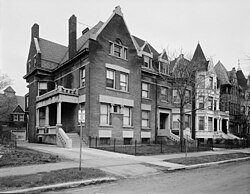Robert S. Abbott House
Robert S. Abbott House | |
 Robert S. Abbott House | |
 | |
| Location | 4742 South Dr. Martin Luther King Jr. Drive, Chicago, IL |
|---|---|
| Coordinates | 41°48′28.9″N 87°37′1.4″W / 41.808028°N 87.617056°WCoordinates: 41°48′28.9″N 87°37′1.4″W / 41.808028°N 87.617056°W |
| Built | c. 1900 |
| Architectural style | Queen Anne |
| NRHP reference No. | 76000686 |
| Significant dates | |
| Added to NRHP | December 8, 1976[1] |
| Designated NHL | December 08, 1976[2] |
The Robert S. Abbott House is a historic house in the Grand Boulevard community area of Chicago, Illinois. Built about 1900, it was home from 1926 until his death of Robert S. Abbott (1870-1940), founder and publisher of the Chicago Defender, the largest-circulation African-American newspaper in the nation. Abbott started this newspaper in 1905 in which he heartened blacks in southern United States to move into north far from racist south.[3] Abbott became one of the few self-made black millionaires in the early 20th century. His home was designated a National Historic Landmark status in 1976.[2][4][5]
Description and history[]
The Robert S. Abbott House stands on Chicago's South Side, north of Washington Park on the west side of Martin Luther King Jr. Boulevard, on the same block that features the Harold Washington Cultural Center on the east side. It stands at the southern end of a group of row houses, and is the left side of an asymmetrical duplex. Its construction date is not known, but is estimated to be about 1900 based on its architectural style, which is a combination of Late Victorian and neo-Classical elements. The combined units share a hip roof, with that on the left featuring a large projecting gabled section two bays in width. To its right is a single bay, set next to the entrance to the adjacent unit, while the left unit's entrance is sheltered under a separate side porch on the left side. The porch has a limestone balustrade, with piers rising to Ionic columns supporting its roof. The interior, which has been further broken up into separate living units, retains some of its original grandeur.[5]
Robert Abbott, an African-American native of Georgia, was trained as a printer at the Hampton Institute, and migrated to Chicago, where he received a law degree at Kent College of Law. Unable to get work as a lawyer, he took a job in the city's printing department, where he conceived of the idea of printing and distributing handbill-sized newspapers to the city's African-American community. Founded in 1905, the Chicago Defender was an immediate success, and eventually grew to become the nation's largest circulation African-American newspaper.[5] The newspaper, which circulated widely outside Chicago, has been described as a major influence in the Great Migration of African Americans out of the South, describing in a positive way conditions in the North, and unflinchingly describing lynchings and other acts of violence against African Americans in the South.
See also[]
- List of National Historic Landmarks in Illinois
- National Register of Historic Places listings in South Side Chicago
References[]
- ^ "National Register Information System". National Register of Historic Places. National Park Service. January 23, 2007.
- ^ a b "Robert S. Abbott House". National Historic Landmark summary listing. National Park Service. Archived from the original on 2008-01-03. Retrieved 2008-03-02.
- ^ Robert S. Abbott House
- ^ National Register of Historic Places: Illinois - Cook County. National Register of Historic Places.com. Retrieved on 25 June 2007.
- ^ a b c Gomez-Graves, Lynne (June 30, 1976). "National Register of Historic Places Inventory-Nomination: Robert S. Abbott House" (pdf). National Park Service. Cite journal requires
|journal=(help) and Accompanying 2 photos, exterior, from 1976. (451 KB)
External links[]
- Historic American Buildings Survey (HABS) No. IL-1092, "Robert S. Abbott House, 4742 Martin Luther King Drive, Chicago, Cook County, IL", 1 photo, 1 photo caption page
- Historic American Buildings Survey in Chicago
- Houses completed in 1900
- Houses on the National Register of Historic Places in Chicago
- National Historic Landmarks in Chicago

